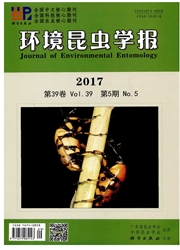

 中文摘要:
中文摘要:
以山东泰安棉铃虫Helicoverpa armigera Hübner为例,在人工饲养条件下、人工气候箱中,研究了不同光周期和温度条件对棉铃虫幼虫生长发育历期、蛹重及蛹历期的影响。结果表明,光周期对棉铃虫幼虫发育历期、非滞育蛹历期均存在一定的影响,短光照(滞育诱导的光周期)下的发育历期要长于长光照(诱导发育的光周期)的发育历期;温度对棉铃虫幼虫发育历期、非滞育蛹历期的影响十分明显,随着温度上升,发育历期明显缩短;棉铃虫蛹的重量形成受到幼虫期的光周期和温度的联合作用,在较高温度(28℃)下,光照时数与蛹重呈现极显著的负相关关系(R^2=0.9257),在短光照(如11h光)下,蛹重与温度呈现正相关性(R^2=0.8564),而在长光照下如15h,蛹重与温度呈现一定的负相关性(R^2=0.523);此外,同一光温下,雌雄蛹重量差异不显著,而滞育蛹要重于非滞育蛹,幼虫发育历期越长形成的蛹一般越重。
 英文摘要:
英文摘要:
Under artificial feeding conditions and artificial climate chamber, we studied on the influence of different photoperiod and temperature conditions on larval developmental period, pupal weight and pupal duration of Helicoverpa armigera, by using a population from Shandong Tai'an as test sample. The results showed that different photoperiod on larval developmental period, duration of non-diapause pupae have certain influence, the developmental period under short photoperiod (a diapause-inducing photoperiod) was longer than that under long photoperiod ( a development-inducing photoperiod). Impact of temperature on larval development duration, non-diapause pupal duration was very obvious, as the temperature increased, developmental time was shortened. The both photoperiod and temperature (28℃), the light hours and pupal weight presented a very significant negative correiation (R^2 = 0. 9257). Under the short daylight, the pupal weight was positively correlated with temperature (R^2 =0. 8564), however, under the long daylight, pupal weight and temperature showed a certain degree of negative correlation (R^2 = 0. 523 ). In addition, at the same daylength and temperature, the pupae weight between male and female was not significant, while the weight of diapause pupae was heavier than that of the non-diapause pupae. Generally, the longer larval developmental period was, the heavier the pupal weight.
 同期刊论文项目
同期刊论文项目
 同项目期刊论文
同项目期刊论文
 Inheritance of photoperiodic induction of larval diapause in the Asian corn borer Ostrinia furnacali
Inheritance of photoperiodic induction of larval diapause in the Asian corn borer Ostrinia furnacali 期刊信息
期刊信息
